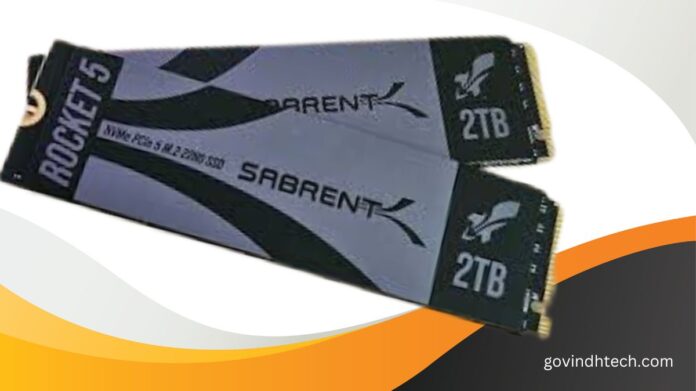Sabrent Rocket 5 2TB SSD
Among the quickest SSDs has been ever tested is the Sabrent Rocket 5. That makes sense because Sabrent gained notoriety in the storage industry with the launch of the Rocket SSD. Additionally, the business released the Rocket Q and Rocket 4 Plus, the first two 8TB M.2 drives, and the Rocket 4 Plus-G, the first drive optimized for Direct Storage. With a lightning-fast PCI e 5.0 SSD that has been promised for a while, it now rises to the front of the pack. The Sabrent Rocket 5 is incredibly fast and has some unique features that set it apart from other drives like the Crucial T705, which is in competition with the top SSDs. The wait has been worthwhile.
Before releasing its first PCIe 5.0 SSD, Sabrent waited to make sure it could maximize the capabilities of the technology. This enables the drive to surpass previous versions such as the Crucial T700, Gigabyte Aorus Gen5 10000, and Corsair MP700, and avoids the need for iterative updates, as was the case with the original Rocket 4 Plus. Also, Sabrent opted not to include a heatsink, which is understandable given that M.2 cooling is a feature included on the majority of expensive motherboards. There are aftermarket heatsinks available as well, and Sabrent produces those too.
Even if they are still concerned about heat generation and power consumption with these expensive PCI e 5.0 SSDs, throttling shouldn’t be an issue if there is sufficient cooling. That’s fortunate because these drives have the potential to push really high numbers. While the Sabrent Rocket 5 doesn’t break any new records when compared to the T705, it does produce some interesting results in our sustained writing testing.
Similar to the Crucial T705, the Sabrent Rocket 5 is priced as follows:
- $189.99 for 1TB, $339.99 for 2TB, and $729.99 for 4TB. With or without the T705’s heatsink, the prices of these two drives are comparable at 1TB and 2TB.
- However, the T705 is now less expensive at 4TB.
- Right present, SSD prices are gradually rising, so things could change.
- There’s a good chance that Sabrent will lead the way in delivering 8TB drives first for the Rocket 5, as they have in the past.
- The first 8TB PCI e 5.0 drive would be a significant accomplishment, but at this point they don’t even want to consider the cost of such a drive.
- Up to 14,000 / 12,000 MB/s can be read and written sequentially on the Sabrent Rocket 5, and up to 1,400K / 1,400K random read and write IOPS can be achieved.
- Although the drives utilize the same technology, these figures are more cautious than the T705, therefore they would anticipate comparable performance levels.
- Along with a five-year warranty, the Rocket boasts a 600TB write capacity per TB capacity. That ought to be more than enough, even with a quick PCI e 5.0 SSD.
Sabrent Rocket 5 Add-ons and Programmes
With its own SSD toolkit, the Rocket Control Panel, and an OEM version of Acronis True Image, Sabrent offers standard software support. The former is helpful for getting firmware upgrades when needed and for assessing the overall health of the drive. The latter is helpful if you already have a system in place for imaging and cloning. Other drives, including the Sabrent Rocket 5, can be used as substitutes with free utilities like Crystal Disk Info and Clone Zella.
A Closer Look at the Sabrent Rocket 5
A straightforward copper heat-spreading label is attached to the top of the Rocket 5, while a more educational label is located on the reverse. Since it is a double-sided drive, more cooling is necessary. When you use an aftermarket M.2 SSD cooler or an M.2 heatsink on your motherboard for your own cooling, the label might stay in place. The drive is not ideal for laptops and should not be used empty. Although there are less expensive PCI e 4.0 solutions that will function similarly in that position, it can nonetheless function in a PS5.
The well-known Phi son E26 SSD controller, one DRAM package, and two NAND flash packages are hidden beneath the copper label. The DRAM is an LPDDR4 package with 4GB capacity from SK Hynix. This is the typical amount of DRAM for Phi son E26 drives, yet it’s double what most 2TB SSDs are supposed to have. 512GB of NAND flash per package, or four 1Tb dies of Micron’s 232-Layer TLC, are contained in the quad die package (QDP) configuration of the NAND packages.
The second pair of NAND flash packages are visible at the back of the drive. From a cooling standpoint, this posture is fascinating. Here, a straightforward backplate or thermal pad should be sufficient because the controller is most likely the main source of the drive’s heat output. You can choose to cool the controller alone, but you really shouldn’t let that stop you from cooling the drive as a whole, or at least everything on top. NAND flash is heat-tolerant, and under certain situations, it may even be better than “too cold” temperatures; nevertheless, for consumer use, the only thing to worry about is keeping the drive from throttling.
Sabrent Rocket 5 release date
Although the Sabrent Rocket 5 SSD’s actual release date is unknown, press reports suggest that it most likely went on sale in early 2024.


